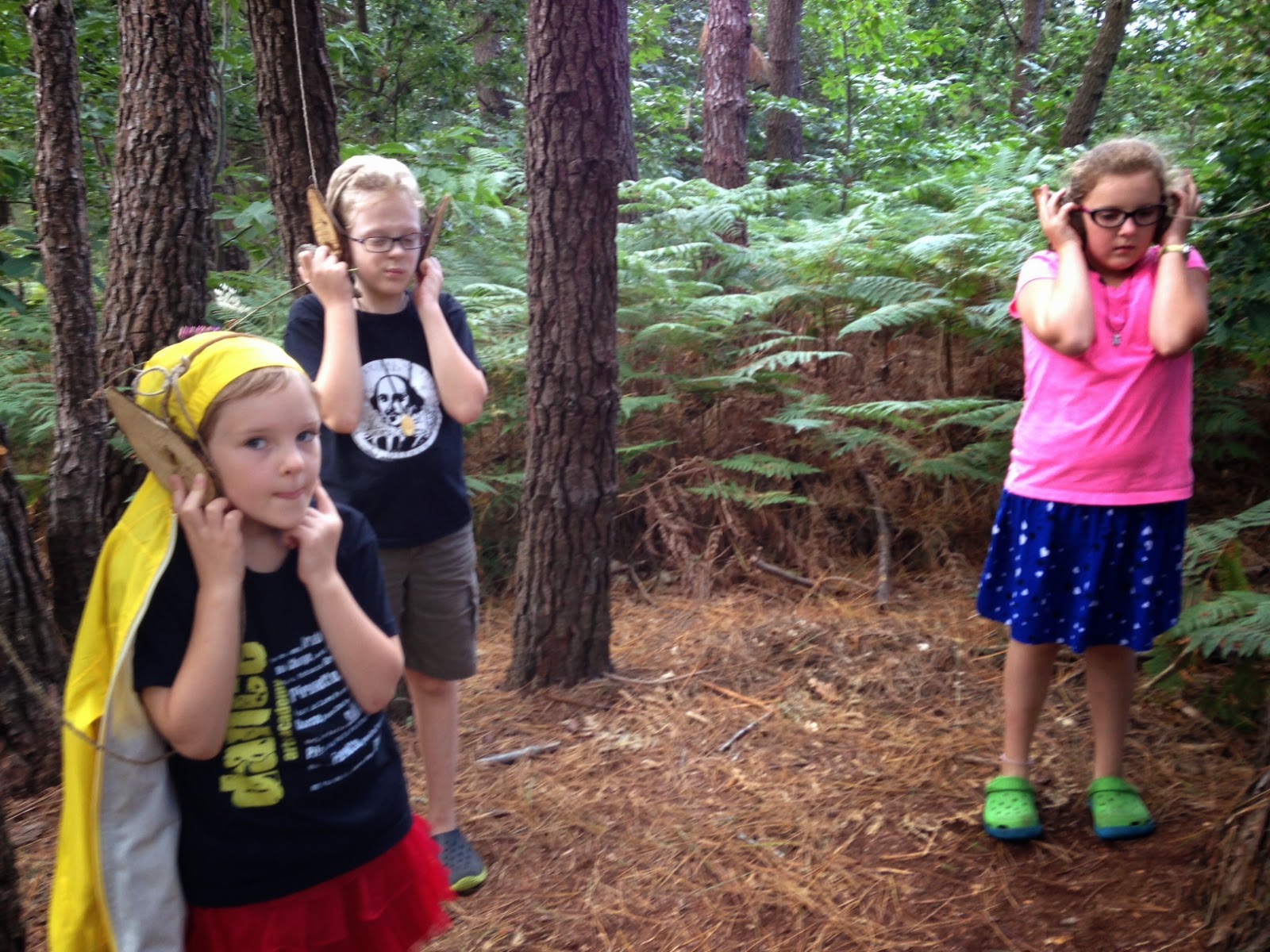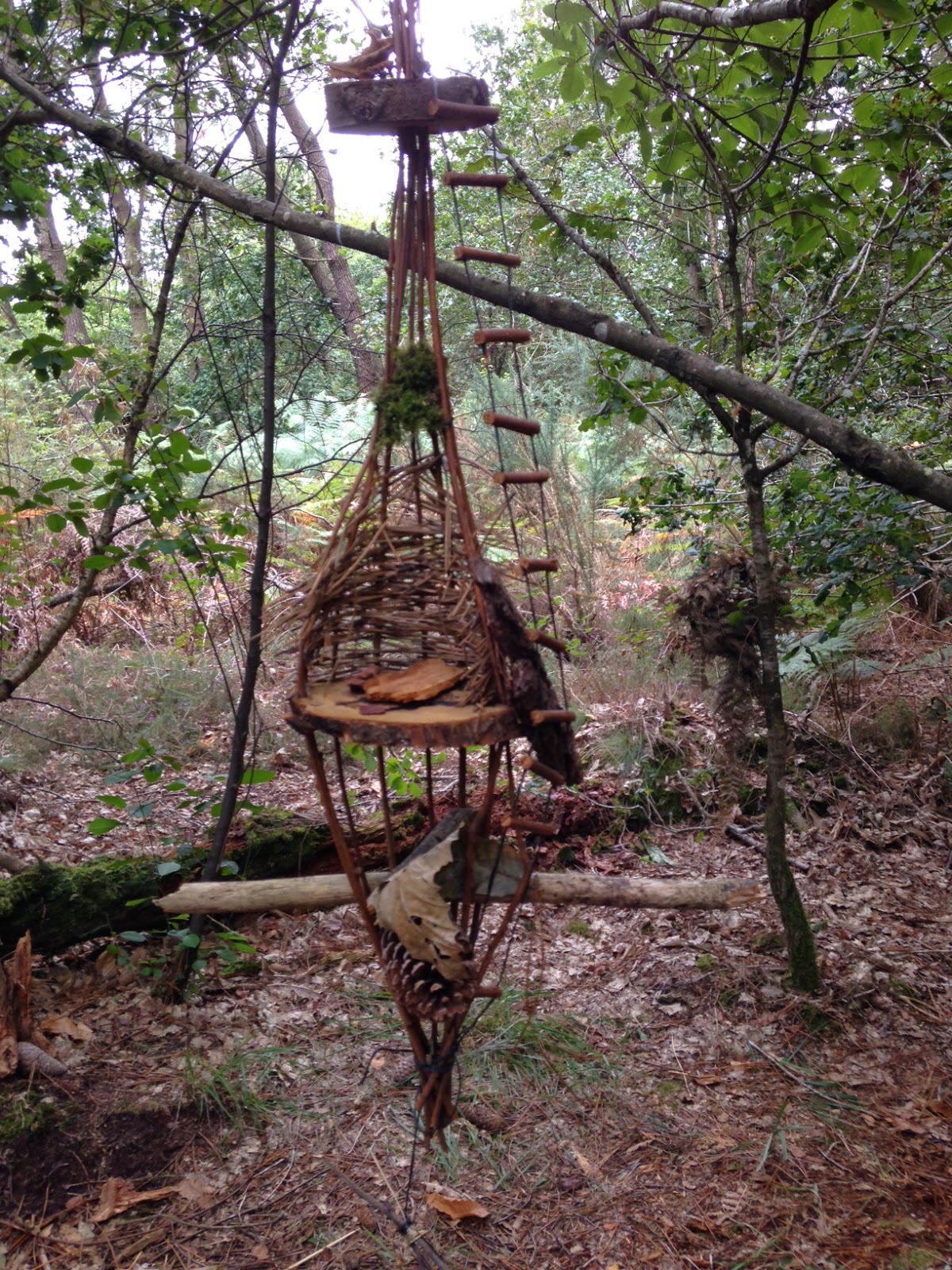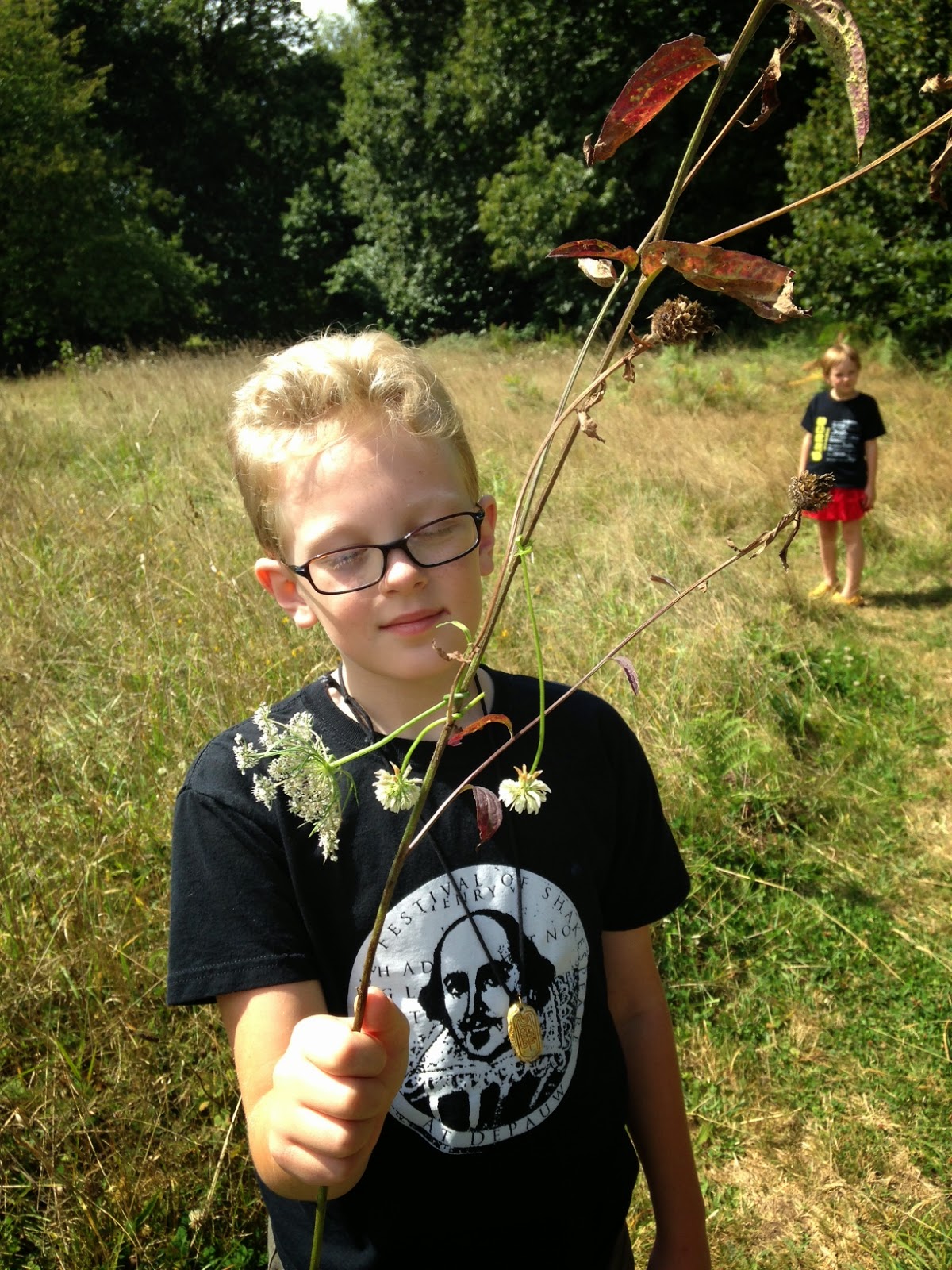Medieval History
 You truly never know where Brittany is going to take you next. We started the day by... making jam! I was the photographer, the girls stirred many things, and David was the orchestrator. Ten (!) jars of nectarine jams later, we were set - accomplished and completely enveloped in the sweetest scent there ever was. We wafted forth into the forest thusly, making our way to Monteneuf, treasured site and unexpected pleasure. In the summers, the place really comes alive with programming well beyond the neolithic megaliths that for its center. And so, we picked up our map and followed the korrigan (elf) Ozégan on his adventures through the forest. I have dozens and dozens of photographs, so we'll have to see if these two can tell a tale. The kids put on elf ears to better hear the sounds of the forest (and they swore it worked, that they heard more tiny insects and creatures with these on. I have an awesome one of Mac with these on - most excellent.
You truly never know where Brittany is going to take you next. We started the day by... making jam! I was the photographer, the girls stirred many things, and David was the orchestrator. Ten (!) jars of nectarine jams later, we were set - accomplished and completely enveloped in the sweetest scent there ever was. We wafted forth into the forest thusly, making our way to Monteneuf, treasured site and unexpected pleasure. In the summers, the place really comes alive with programming well beyond the neolithic megaliths that for its center. And so, we picked up our map and followed the korrigan (elf) Ozégan on his adventures through the forest. I have dozens and dozens of photographs, so we'll have to see if these two can tell a tale. The kids put on elf ears to better hear the sounds of the forest (and they swore it worked, that they heard more tiny insects and creatures with these on. I have an awesome one of Mac with these on - most excellent.
 The trail is a couple of kilometers long and dotted with one incredible site after another. The korrigan villages were the best - miniature scale inhabitations strung within and between trees: suspended platforms and swings and ladders and little stones leading to fissures in tree trunks. And the kids were invited to add on, to build more little houses and spaces for the korrigans. The rain came and went, with each departure leaving wisps of steam as the sun shone brightly into the forest, making elven shapes and sounds as leaves rustled to shake off their water. It was utterly fantastic: Lord of the Rings meets nature hike; Avatar gone Celtic. All three kids built little houses, all with fantastic fern coverings (the fern grows and grows here, 4 feet tall and plentiful, ready to be interwoven into complex roofs. The 19th-century stories of Brittany interwove the Celtic korrigans with the megaliths: they were the ones to understand the huge stones, to nimbly scale their heights and wisely keep their secrets. Why change the story in the 21st century? The trail circled around dormant stones, the great majority of the 420-plus stones of Monteneuf - why not awaken them with child's play?
The trail is a couple of kilometers long and dotted with one incredible site after another. The korrigan villages were the best - miniature scale inhabitations strung within and between trees: suspended platforms and swings and ladders and little stones leading to fissures in tree trunks. And the kids were invited to add on, to build more little houses and spaces for the korrigans. The rain came and went, with each departure leaving wisps of steam as the sun shone brightly into the forest, making elven shapes and sounds as leaves rustled to shake off their water. It was utterly fantastic: Lord of the Rings meets nature hike; Avatar gone Celtic. All three kids built little houses, all with fantastic fern coverings (the fern grows and grows here, 4 feet tall and plentiful, ready to be interwoven into complex roofs. The 19th-century stories of Brittany interwove the Celtic korrigans with the megaliths: they were the ones to understand the huge stones, to nimbly scale their heights and wisely keep their secrets. Why change the story in the 21st century? The trail circled around dormant stones, the great majority of the 420-plus stones of Monteneuf - why not awaken them with child's play?
 The 42 standing megaliths are still a 2km drive away. They stand apart, with a precise pedagogical space and mission. This is, might as well claim it, probably my favorite site in Brittany. Inland megaliths, in some kind of parallel or communication or exchange with the coastal arrangements of Carnac. We took students here during the January 2013 "Legend and Landscape" Winter Term trip - students dragged a stone and raised it, got muddy, persevered. This time it was sunny (then rainy, then sunny again), and I tried a funky "chrome" setting on my camera - it looks like a colorized postcard, I love it. This site has always interested me so much. I would love to write about it someday, especially in its medieval chapter. Now we know that there are over 420 stones in the alignment (most of them in farmers' fields, the original set-up lost forever), but until the fire that started exposing them in 1989, there were only three standing stones. Paleo-botany revealed that the stones had been put down around the year 1000 - that's the medieval chapter I'd love to uncover. Putting down megaliths is difficult (as difficult?) work - a tremendous effort, it seems in response to a tremendous force or pull of the stones. There may be nothing more than the paleo-botany to tell the tale (though there are plenty of decrees in England and France from the period banning gathering at stones and trees), but I would like to keep going with it, see where it takes me. I bought the archaeological report right before the office closed and felt lucky.
The 42 standing megaliths are still a 2km drive away. They stand apart, with a precise pedagogical space and mission. This is, might as well claim it, probably my favorite site in Brittany. Inland megaliths, in some kind of parallel or communication or exchange with the coastal arrangements of Carnac. We took students here during the January 2013 "Legend and Landscape" Winter Term trip - students dragged a stone and raised it, got muddy, persevered. This time it was sunny (then rainy, then sunny again), and I tried a funky "chrome" setting on my camera - it looks like a colorized postcard, I love it. This site has always interested me so much. I would love to write about it someday, especially in its medieval chapter. Now we know that there are over 420 stones in the alignment (most of them in farmers' fields, the original set-up lost forever), but until the fire that started exposing them in 1989, there were only three standing stones. Paleo-botany revealed that the stones had been put down around the year 1000 - that's the medieval chapter I'd love to uncover. Putting down megaliths is difficult (as difficult?) work - a tremendous effort, it seems in response to a tremendous force or pull of the stones. There may be nothing more than the paleo-botany to tell the tale (though there are plenty of decrees in England and France from the period banning gathering at stones and trees), but I would like to keep going with it, see where it takes me. I bought the archaeological report right before the office closed and felt lucky.
 And then to come home to David and supper and stories, and to see all of the pictures and find a place for the stalk that Oliver interlaced with flowers and fern until it eventually became a shaman stick. To realize that these stories, these korrigans, have a lightness of touch that allows them to escape the exactitudes of history and the precisions of literature. That they never quite let go of the forest, nor it of them, and that with a few twists of ferns and curves of branches the stories can start again, each structure adding another layer, another possibility of the forest coming alive after we've left it. To wonder at what is conjuring what. To feel the good fortune to enter into these stories and spaces and emerge from them to share them with a friend who really hears them. That, that is a gift from many sources.
And then to come home to David and supper and stories, and to see all of the pictures and find a place for the stalk that Oliver interlaced with flowers and fern until it eventually became a shaman stick. To realize that these stories, these korrigans, have a lightness of touch that allows them to escape the exactitudes of history and the precisions of literature. That they never quite let go of the forest, nor it of them, and that with a few twists of ferns and curves of branches the stories can start again, each structure adding another layer, another possibility of the forest coming alive after we've left it. To wonder at what is conjuring what. To feel the good fortune to enter into these stories and spaces and emerge from them to share them with a friend who really hears them. That, that is a gift from many sources.
- By The River With 7th Graders, Mary Oliver, And Fafnir
There was an outing today. 150 kids, the entirety of the 7th grade, a drive out of our small town, and through Amish country to one of our glorious state parks. Warm, breezy, clear air redirected by cries of glee and teasing, kids running ahead, kids...
- Thoreau On Carnac
Thoreau, though he never left these American shores, wrote about Carnac! At this late hour, I can do little but happily quote favorite lines and revel in his own mixed emotions. He's traveling down the Concord and Merrimack rivers and he starts...
- History Of Emotions
Is it the third time that makes it familiar? does the third time make it mine? Coming in and out of jet lag unconsciousness on the bus, I read Campaneac, Malestroit, one fleeting glimpse of Josselin before turning off for Vannes... I love this place so...
- Thorough Thoreau
I would be willing to bet that Thoreau did not have children when taking his walks, especially six year olds who do not suffer pebbles in their shoes gladly. The fall colors are here, quite suddenly it seems, and so we take to the woods. But...
- Stones (avanim)
Crusader Column in BethlehemIs it possible to write the world's shortest blog entry? I am so so tired, and tomorrow am giving a talk to my colleagues that I'd like to be peppy for (is 46 images of monsters, orientalism and morality too much for...
Medieval History
Korrigans Now and Then
- By The River With 7th Graders, Mary Oliver, And Fafnir
There was an outing today. 150 kids, the entirety of the 7th grade, a drive out of our small town, and through Amish country to one of our glorious state parks. Warm, breezy, clear air redirected by cries of glee and teasing, kids running ahead, kids...
- Thoreau On Carnac
Thoreau, though he never left these American shores, wrote about Carnac! At this late hour, I can do little but happily quote favorite lines and revel in his own mixed emotions. He's traveling down the Concord and Merrimack rivers and he starts...
- History Of Emotions
Is it the third time that makes it familiar? does the third time make it mine? Coming in and out of jet lag unconsciousness on the bus, I read Campaneac, Malestroit, one fleeting glimpse of Josselin before turning off for Vannes... I love this place so...
- Thorough Thoreau
I would be willing to bet that Thoreau did not have children when taking his walks, especially six year olds who do not suffer pebbles in their shoes gladly. The fall colors are here, quite suddenly it seems, and so we take to the woods. But...
- Stones (avanim)
Crusader Column in BethlehemIs it possible to write the world's shortest blog entry? I am so so tired, and tomorrow am giving a talk to my colleagues that I'd like to be peppy for (is 46 images of monsters, orientalism and morality too much for...
